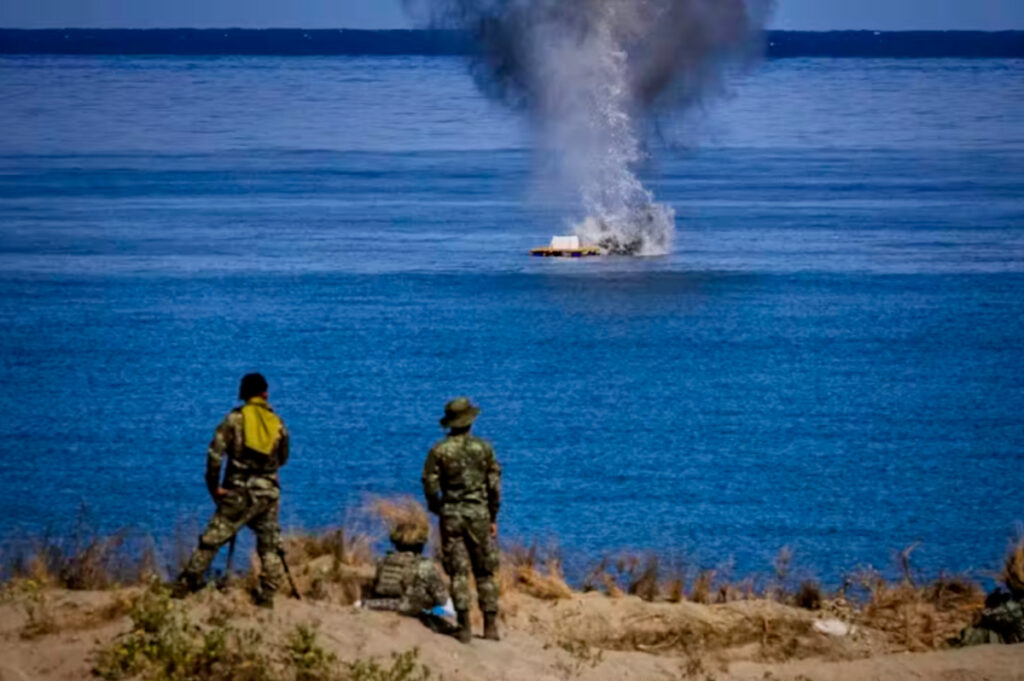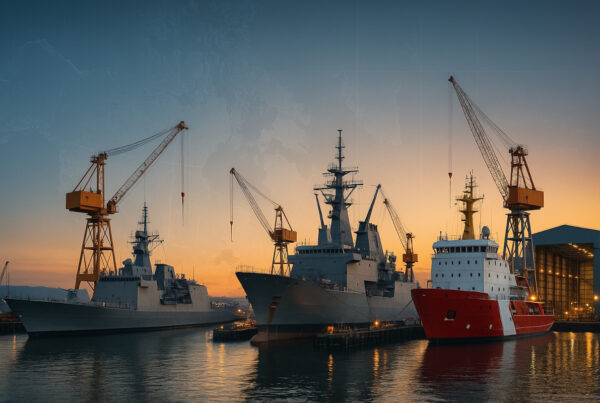Filipino officials lobbying for US-Philippine mutual defense treaty reset that lowers the threshold for US military intervention

Philippine troops watch as a missile hits a target during a live-fire joint US-Philippines exercise. Photo: Ezra Acayan / Getty Images / YouTube Screengrab
(Written by Richard Davad Heydarian. Published here in Asia Times, republished with permission.)
MANILA – Will the Sabina Shoal be the trigger point for US intervention in the escalating China-Philippine clashes in the contested South China Sea?
Over the weekend, Chinese and Philippine Coast Guard vessels jousted over the low tide feature situated just 138 kilometers from the Philippines’ west coast and 1,200 kilometers from China’s southernmost province of Hainan.
The Philippines claims Sabina Shoal as part of its exclusive economic zone (EEZ), while Beijing insists it falls within its expansive nine-dash line claim to most of the South China Sea.
As with previous sea clashes over other contested shoals and features, both sides blamed the other for the ship collision. Chinese Coast Guard (CCG) spokesman Liu Dejun accused the Philippine Coast Guard (PCG) of “deliberately collid[ing]” with one of its ships near the shoal.
“The Philippine ship No 9701 deliberately collided with the Chinese ship No 5205, which was normally enforcing rights and law enforcement, in an unprofessional and dangerous manner, resulting in a collision,” the Chinese spokesman said. He added the “responsibility lies entirely with the Philippines.”
The PCG spokesperson Jay Tarriela fired back by accusing Chinese forces of “deliberately ramming” the PCG’s flagship vessel, the BRP Teresa Magbanua, three times without provocation.
“This afternoon, the Chinese Coast Guard vessel deliberately rammed and collided with the ship, despite no provocation from the Philippine Coast Guard,” he wrote in a post on X.
Washington quickly sided with its mutual defense treaty ally, the Philippines, with the US State Department condemning China for “deliberately colliding three times” with the PCG vessel.
“On multiple occasions throughout August 2024, (China) has aggressively disrupted lawful Philippine aerial and maritime operations in the South China Sea, including at Sabina Shoal,” US State Department spokesperson Matthew Miller said.
Rather than de-escalating tensions, however, China has doubled down by deploying an armada of militia vessels to the disputed sea area in the Spratly Island chain.
According to Philippine authorities, China has parked the largest number of CCG and Chinese maritime militia (CMM) vessels ever in the contested maritime area, underscoring China’s preponderance of force vis-à-vis the Philippines.
A total of 203 ships were spotted between August 27 to September 2, with as many as 71 deployed near the Sabina Shoal alone.
With China expanding its presence and steadily eroding the Philippines’ patrol and resupply capacity through ship collisions, Philippine President Ferdinand Marcos Jr’s administration is now openly debating a major reset of its US defense alliance.
The Philippine Navy’s Rear Admiral Alexandar Lopez has openly called for a “review” of the Philippine-US Mutual Defense Treaty (MDT) while Defense Secretary Gilbert Teodoro Jr has lobbied for “collective multilateral action” with likeminded regional states to counter China.
Following a meeting with US Indo-Pacific Command (INDOPACOM) chief Samuel Paparo, Armed Forces of the Philippines (AFP) chief General Romeo Brawner Jr said that joint patrols and resupply missions with the US would be a “last resort” if China continues to escalate tensions.
Despite such hedging, the risk of armed conflict is clearly rising. China likely fears another strategic setback after Manila recently successfully fortified its de facto military base, the grounded BRP Sierra Madre vessel, over the contested Second Thomas Shoal.
After repeated interceptions and aggressive interventions failed to deter Manila, Beijing settled for a vague “interim agreement” that allowed both sides to save face and de-escalate tensions for what proved to be only a short period.
Now, China likely fears an emboldened Philippines will try to replicate its success at the Second Thomas Shoal by fortifying its claimed features across the Spratly Islands, including over the Sabina Shoal.
Although China has so far refrained from kinetically imposing its will, it has been relatively successful in degrading the Philippines’ resupply and patrol capacity by damaging its vessels.
Top Philippine strategists such as retired Rear Admiral Rommel Jude Ong have warned against China’s “mission kill” tactics, whereby Beijing deliberately damages the Philippines’ limited fleet of high-performance vessels.
In response, Philippine officials are doubling down on efforts to build and acquire a variety of new coast guard and naval vessels from various partners and allies.
So far, Japan and South Korea have been the Philippines’ biggest suppliers of coast guard and naval assets, respectively. But there is now a push for Manila to rapidly acquire more affordable, recently retired US naval assets.
Last month, the two allies held the first-ever “two plus two” summit in Manila, at which US Secretary of State Antony Blinken and US Defense Secretary Lloyd Austin announced a new US$500 million defense aid package for the Philippines.
That sum, of course, won’t be nearly enough to counterbalance China’s rising military and naval might, as upgrading the Philippines’ laggard naval capacity will take years and cost billions.
As such, there is a push to upgrade the Philippine-US alliance in ways that have a more immediate deterrent effect since China has been deploying varying and increasingly aggressive forms of “gray zone” tactics. Philippine critics say China has deployed the tactics with “strategic impunity.”
Admiral Alexander Lopez, spokesman of the National Maritime Council (NMC), a body that oversees interagency coordination on Philippine strategy in the South China Sea, recently called for a formal “review” of the MDT.
“For me, the MDT has been there since 1951, and since then, the strategic landscape has changed so much. So, maybe it’s high time now to make the review,” Lopez explained, without clarifying what exact provisions he sought to revise.
For some Filipino strategists, the US could revise its definition of “armed attack” and, accordingly, adjust the threshold for formal activation of mutual defense obligations to deter and blunt China’s gray zone tactics.
The Philippine military chief, however, has insisted that so far his forces are capable of handling the situation. “The attitude of the Armed Forces of the Philippines, as dictated by the Philippine laws, is for us to first rely on ourselves,” Brawner said following a meeting with the visiting US INDOPACOM commander.
“We are going to try all options, all avenues that are available to us in order for us to achieve the mission…in this case, the resupply and rotation of our troops.”
Nevertheless, he clarified that if China continues with its aggressive maneuvers, the Philippines will “then seek for other options when we are already constrained from doing it ourselves,” including joint patrols and resupply missions with American forces.
Philippine Defense Secretary Teodoro Jr has underscored the importance of a multilateral approach, one which ensures the Southeast Asian nation maintains its strategic autonomy, avoids overdependence on the US and leverages its wide network of strategic partnerships.
“The antidote is a stronger collective multilateral action against China,” Teodoro said, emphasizing that diplomatic statements alone from key allies are “not enough” to deter China.
Sensing growing frustration in Manila, US officials have tried to reassure their Philippine treaty ally and underscored their commitment to a more effective deterrence of China’s intimidation tactics.
“We certainly have prepared a range of options and USINDOPACOM stands ready, if so called, after consultations in accordance with the treaty to execute those shoulder to shoulder with our ally,” US INDOPACOM commander Samuel Paparo said during a recent surprise visit to the Philippines.
However, he refused to provide operational details to prevent China from mounting “a countermeasure to those.”
Follow Richard Javad Heydarian on X at @Richeydarian








